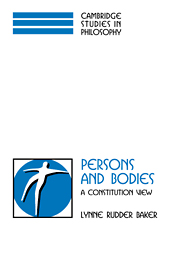1 - Persons in the Material World
Published online by Cambridge University Press: 05 June 2012
Summary
“But what, then, am I?” Descartes famously asked in the Meditations. Descartes then set the philosophical stage for the next few hundred years with his equally famous answer: “A thing that thinks. What is that? A thing that doubts, understands, affirms, denies, wills, refuses and which also imagines and senses.” But what kind of thing is a thing that thinks? Descartes's own answer — that a thinking thing is an immaterial mind — has lost ground over the centuries. Today neoCartesian materialists typically take the thinking thing to be the brain and then go on to try to determine how particular neural states can be the mental states involved in thinking (e.g., beliefs, desires, and intentions). But the thinker — the thing that thinks, that has an inner life — is neither an immaterial mind nor a material brain: it is the person. My brain is the organ by which I think; but I, a person embedded in a material world, am the thinker. So, where traditional Cartesians see a mind/body problem and neo- Cartesians see a mental-state/brain-state problem, I see a person/body problem: What is a human person, and what is the relation between a person and her body? This is the problem that I shall investigate here.
According to the solution that I shall offer, a human person is constituted by a human body. But a human person is not identical to the body that constitutes her.
- Type
- Chapter
- Information
- Persons and BodiesA Constitution View, pp. 3 - 26Publisher: Cambridge University PressPrint publication year: 2000



